Related Research Articles
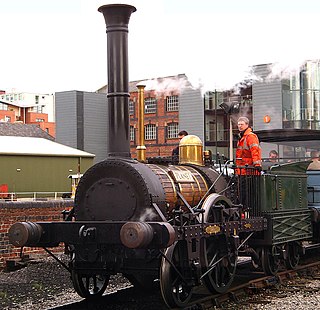
Under the Whyte notation for the classification of steam locomotives, 2-2-0 represents the wheel arrangement of two leading wheels on one axle, two powered driving wheels on one axle, and no trailing wheels. This configuration, which became very popular during the 1830s, was commonly called the Planet type after the first locomotive, Robert Stephenson's Planet of 1830.
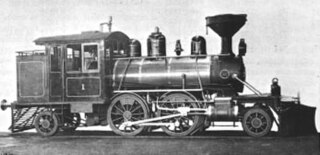
Under the Whyte notation for the classification of steam locomotives, 2-4-2 represents the wheel arrangement of two leading wheels on one axle, four powered and coupled driving wheels on two axles and two trailing wheels on one axle. The type is sometimes named Columbia after a Baldwin 2-4-2 locomotive was showcased at the 1893 World's Columbian Exposition held at Chicago, Illinois.
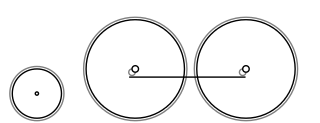
Under the Whyte notation for the classification of steam locomotives, 2-4-0 represents the wheel arrangement of two leading wheels on one axle, four powered and coupled driving wheels on two axles and no trailing wheels. In most of North America it became known as a Porter.

Under the Whyte notation for the classification of steam locomotives, 0-4-4 represents the wheel arrangement of no leading wheels, four powered and coupled driving wheels on two axles, and four trailing wheels on two axles. This type was only used for tank locomotives.
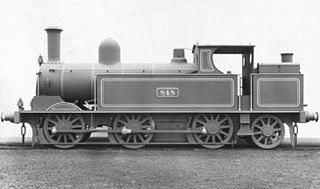
The London and North Western Railway (LNWR) Webb Coal Tank is a class of 0-6-2T steam locomotive. They were called "Coal Tanks" because they were a side tank version of Webb's standard LNWR 17in Coal Engine, an 0-6-0 tender engine for slow freight trains.
Under the Whyte notation for the classification of steam locomotives, 0-2-4 represents the wheel arrangement of no leading wheels, two powered driving wheels on one axle, and four trailing wheels on two axles.

The London and North Western Railway Experiment Class was a series of 30 three-cylinder 2-(2-2)-0 compound locomotives designed by Francis Webb for the London and North Western Railway between 1882 and 1884. They were Webb’s first large-scale experiment with a class of express compound locomotives, and the first engine was named accordingly. They were followed by a class of similar, but larger locomotives, that featured larger boilers and smaller driving wheels – the LNWR Dreadnought Class.

Under the Whyte notation for the classification of steam locomotives, 2-2-2-2 could represent either the wheel arrangement of two leading wheels, four powered but uncoupled driving wheels, and two trailing wheels; or of two independent leading axles, two driving wheels, and two trailing wheels.
Under the Whyte notation for the classification of steam locomotives, 2-2-4-0T represents the wheel arrangement of two leading wheels on one axle, two driving wheels powered from the inside cylinders, four coupled driving wheels powered from the outside cylinders but no trailing wheels.

The London and North Western Railway (LNWR) 1400 Class, commonly known as Bill Baileys after the popular little music hall number "Won't You Come Home Bill Bailey", was a class of 30 4-cylinder 4-6-0 compound locomotives. Essentially a Class B compound 0-8-0 with different wheel arrangement. 30 were built starting in 1903, intended for a mixed traffic role. The first was withdrawn in 1913, with several more following during the First World War, cannibalised to keep Class Bs running. None survived to the grouping of 1923; the last was withdrawn in 1921.
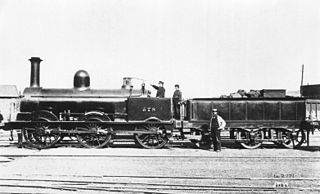
The London and North Western Railway (LNWR) DX Goods class was a class of 0-6-0 steam locomotive, designed by John Ramsbottom for freight duties. 943 were constructed, making them the largest single class of steam locomotives built in the United Kingdom. Despite this, none were preserved.
Under the Whyte notation for the classification of steam locomotives, 0-2-2-0 represents the wheel arrangement of no leading wheels, four powered but uncoupled driving wheels on two axles, and no trailing wheels. Some authorities place brackets around the duplicated but uncoupled wheels, creating a notation 0-(2-2)-0.
The Glasgow and South Western Railway (GSWR) 99 class was a class of four 0-2-2-0 steam locomotives designed in 1855.

The LNWR Dreadnought class was a class of 40 passenger three-cylinder compound 2-2-2-0 locomotives designed by F. W. Webb for the London and North Western Railway, and manufactured by them in their Crewe Works between 1884 and 1888. The railway also commissioned the Beyer, Peacock and Company to construct an additional locomotive of the design for the Pennsylvania Railroad.

The LNWR Teutonic class was a class of 10 passenger three-cylinder compound 2-2-2-0 locomotives designed by F. W. Webb for the London and North Western Railway, and manufactured by them in their Crewe Works between 1889 and 1890.
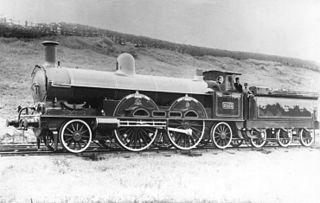
The London and North Western Railway (LNWR) Greater Britain class was a class of ten 2-2-2-2 steam locomotives designed for express passenger work by F. W. Webb.
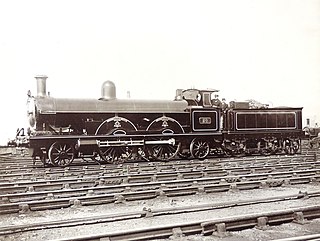
The London and North Western Railway (LNWR) John Hick class was a class of ten 2-2-2-2 steam locomotives designed for express passenger work by F. W. Webb.

The LNWR 18-inch Tank class was a class of 80 0-6-2T locomotives built by the London and North Western Railway in their Crewe Works between 1898 and 1902.

The LNWR 5ft 6in Tank was a class of 160 passenger 2-4-2T locomotives manufactured by the London and North Western Railway in their Crewe Works between 1890 and 1897. The "5ft 6in" in the title referred to the diameter of the driving wheels – although the stated dimension was for the wheel centres – the nominal diameter including the tyres was 5 ft 8+1⁄2 in (1,740 mm).

The LNWR Samson Class was a class of ninety 2-4-0 steam locomotives built by the London and North Western Railway at their Crewe Works between 1863 and 1879.
References
- ↑ Baxter, Bertram (1977). British locomotive catalogue 1825-1923. Vol. 1. Buxton: Moorland Publishing. p. 12. ISBN 978-0-903485-50-0.
- ↑ Baxter, pp.45 & 67.
- ↑ Casserley, H.C. (1960). Historic locomotive pocket book. London: Batsford. p. 51.
- ↑ Baxter, (1977) pp.45 & 67.
- ↑ Baxter, Bertram (1979). 'British locomotive catalogue 1825-1923. Vol. 2b. Buxton: Moorland Publishing. p. 196. ISBN 0-903485-84-2.
- ↑ Roland Arzul (15 December 2008). "Les locomotives 220 type Nord de la Compagnie de l'Etat" (in French). Retrieved 2 November 2023..